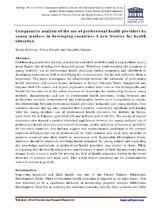| dc.contributor.author | Kabongo, Muika | |
| dc.contributor.author | Stiegler, Nancy | |
| dc.contributor.author | Kanayo, Ogujiuba | |
| dc.date.accessioned | 2018-05-21T11:28:08Z | |
| dc.date.available | 2018-05-21T11:28:08Z | |
| dc.date.issued | 2016 | |
| dc.identifier.citation | Kabongo, M. et al (2016). Comparative analysis of the use of professional health providers by young mothers in developing countries: A new frontier for health education. African Journal for Physical Activity and Health Sciences, 22(2:2): 525-542. http://hdl.handle.net/10520/EJC192215 | en_US |
| dc.identifier.issn | 2411-6939 | |
| dc.identifier.uri | https://hdl.handle.net/10520/EJC192215 | |
| dc.identifier.uri | http://hdl.handle.net/10566/3710 | |
| dc.description.abstract | Childbearing accelerates the risk of maternal and child morbidity and young mothers have a much higher risk of dying from maternal causes. Therefore, understanding the dynamics of young mothers’ use of professional health providers during pregnancy and childbirth in developing countries as well as identifying the socioeconomic factors that influence them is imperative. The paper investigates the relationship between the utilization of professional health providers and socioeconomic influence in Kenya, Ethiopia, Haiti, Bangladesh and Guyana. Both Chi-square and logistic regression models were used on the Demographic and Health Survey data set of the select countries to determine the relationship between young mothers’ characteristics and use of professional health providers. Using bivariate and multivariate analysis, socioeconomic and demographic factors were triangulated to capture the relationships between professional health providers’ utilization and young mothers. Test statistics showed that age and education had a positive, statistically significant relationship with the young mothers’ use of professional health providers for delivery in Kenya, (p=0.01<0.05) in Ethiopia (p=0.01<0.05) and in Haiti (p=0.01<0.05). The results of logistic regression also showed a positive statistical significance between the young mothers’ use of professional health providers and level of education, wealth, and place of residence (p=0.05)
for the select countries. Our findings suggest that socioeconomic conditions in the selected countries influence the use of professionals for both prenatal and natal care. In order to improve maternal and child health in accordance with Sustainable Development Goals, emphasis should be placed on providing health education for young women and expanding the knowledge curriculum of professional health providers that attend to them. While recognizing that the health educator has contributions to make on both the micro and macro change levels, a case is made for moving the field of health education further in the broad direction of prenatal and natal care. This would impact positively on the socioeconomic status of women in general. | en_US |
| dc.language.iso | en | en_US |
| dc.publisher | AFAHPER-SD | en_US |
| dc.rights | This is the author version of the article published online at: https://hdl.handle.net/10520/EJC192215 | |
| dc.subject | Maternal | en_US |
| dc.subject | Child | en_US |
| dc.subject | Morbidity | en_US |
| dc.subject | Socioeconomic | en_US |
| dc.subject | Health Delivery | en_US |
| dc.title | Comparative analysis of the use of professional health providers by young mothers in developing countries: A new frontier for health education | en_US |
| dc.type | Article | en_US |
| dc.privacy.showsubmitter | FALSE | |
| dc.status.ispeerreviewed | TRUE | |
| dc.description.accreditation | DHET | |

